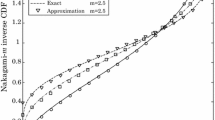Abstract
Maximum Likelihood (ML) method has an excellent performance for Direction-Of-Arrival (DOA) estimation, but a mul-tidimensional nonlinear solution search is required which complicates the computation and prevents the method from practical use. To reduce the high computational burden of ML method and make it more suitable to engineering applications, we apply the Artificial Bee Colony (ABC) algorithm to maximize the likelihood function for DOA estimation. As a recently proposed bio-inspired computing algorithm, ABC algorithm is originally used to optimize multivariable functions by imitating the behavior of bee colony finding excellent nectar sources in the nature environment. It offers an excellent alternative to the conventional methods in ML-DOA estimation. The performance of ABC-based ML and other popular meta-heuristic-based ML methods for DOA estimation are compared for various scenarios of convergence, Signalto-Noise Ratio (SNR), and number of iterations. The computation loads of ABC-based ML and the conventional ML methods for DOA estimation are also investigated. Simulation results demonstrate that the proposed ABC based method is more efficient in computation and statistical performance than other ML-based DOA estimation methods.
Similar content being viewed by others
References
Stoica P, Sharman K C. Maximum likelihood methods for direction-of-arrival estimation. IEEE Transactions on Acoustics, Speech and Signal Processing, 1990, 38, 1132–1143.
Schmidt R O. Multiple emitter location and signal parameter estimation. IEEE Transactions on Antennas and Propagations, 1986, 34, 276–280.
Roy R, Kailath T. ESPRIT-estimation of signal parameters via rotational invariance techniques. IEEE Transactions on Acoustics, Speech and Signal Processing, 1989, 37, 984–995.
Ziskind I, Wax M. Maximum likelihood localization of multiple sources by alternating projection. IEEE Transactions on Acoustics, Speech and Signal Processing, 1988, 36, 1553–1559.
Fessler J, Hero A. Space-alternating generalized expectation-maximization algorithm. IEEE Transactions on Signal Processing, 1994, 42, 2664–2677.
Bresler Y, Macovski A. Exact maximum likelihood parameter estimation of superimposed exponential signals in noise. IEEE Transactions on Acoustics, Speech and Signal Processing, 1986, 34, 1081–1089.
Gershman A B, Stoica P. New MODE-based techniques for direction finding with an improved threshold performance. Signal Processing, 1999, 76, 221–235.
Lopes A, Bonatti I S, Peres P L D, Alves C A. Improving the MODEX algorithm for direction estimation. Signal Processing, 2003, 83, 2047–2051.
McClurkin G D, Sharman K C, Durrant T S. Genetic algorithms for spatial spectral estimation. Proceedings of Fourth Annual ASSP Workshop on Spectrum Estimation and Modeling, Minneapolis, USA, 1988, 318–322.
Li M, Lu Y. Genetic algorithm based maximum likelihood DOA estimation. Proceedings of RADAR, Edinburg, UK, 2002, 502–506.
Zeng J, He Z, Liu B. Maximum likelihood DOA estimation using particle swarm optimization algorithm. Proceedings of CIE International Conference on Radar, Shanghai, China, 2006, 1–4.
Li M H, Lu Y L. Maximum likelihood DOA estimation in unknown colored noise fields. IEEE Transactions on Aerospace and Electronics Systems, 2008, 44, 1079–1090.
Boccato L, Krummenauer R, Attux R, Lopes A. Application of natural computing algorithms to maximum likelihood estimation of direction of arrival. Signal Processing, 2012, 92, 1338–1352.
Yan W, Zhu Z. Maximum likelihood DOA estimation by real-valued genetic algorithm. Proceedings of IEEE National Aerospace and Electronics Conference, Dayton, USA, 2000, 633–636.
Li M H, Lu Y L. Improving the performance of GA-ML DOA estimator with a resampling scheme. Signal Processing, 2004, 84, 1813–1822.
Li M H, Lu Y L. Accurate direction-of-arrival estimation of multiple sources using a genetic approach. Wireless Communications and Mobile Computing, 2005, 5, 343–353.
Karaboga D, Basturk B. A powerful and efficient algorithm for numerical function optimization: artificial bee colony (ABC) algorithm. Journal of Global Optimization, 2007, 39, 459–471.
Karaboga D, Basturk B. On the performance of artificial bee colony(ABC) algorithm. Applied Soft Computing, 2008, 8, 687–697.
Karaboga D, Akay B. A survey: algorithms simulating bee swarm intelligence. Artificial Intelligence Review, 2009, 31, 61–85.
Karaboga D, Akay B. A comparative study of artificial bee colony algorithm. Applied Mathematics and Computation, 2009, 214, 108–132.
Dayong Z, Hongyuan G, Ming D, Chunlian A. Direction finding of maximum likelihood algorithm using artificial bee colony in the impulsive noise. Proceedings of the International Conference on Artificial Intelligence and Computational Intelligence, Sanya, China, 2010, 102–105.
Krim H, Viberg M. Two decades of array signal processing research: the parametric approach. IEEE Signal Processing Magazine, 1996, 13, 67–94.
Karaboga D, Gorkemli B, Ozturk C, Karaboga N. A comprehensive survey: artificial bee colony(ABC) algorithm and applications. Artificial Intelligence Review, 2012, in Press. DOI: 10.1007/s10462–012–9328–0.
Xu C, Duan H. Artificial bee colony(ABC) optimized edge potential function(EPF) approach to target recognition for low-altitude aircraft. Pattern Recognition Letters, 2010, 31, 1759–1772.
Author information
Authors and Affiliations
Corresponding author
Rights and permissions
About this article
Cite this article
Zhang, Z., Lin, J. & Shi, Y. Application of artificial bee colony algorithm to maximum likelihood DOA estimation. J Bionic Eng 10, 100–109 (2013). https://doi.org/10.1016/S1672-6529(13)60204-8
Published:
Issue Date:
DOI: https://doi.org/10.1016/S1672-6529(13)60204-8




